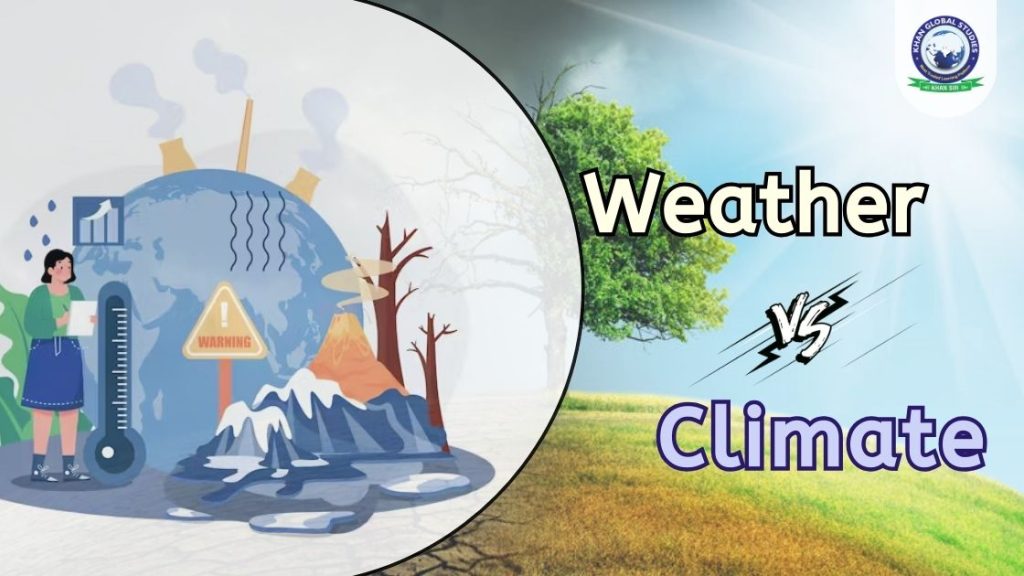Imagine you are stepping outside. Is it a breezy, sun-drenched day or a torrential downpour? That is the weather, the ever-changing symphony of the atmosphere that exhibits daily variations in temperature, rainfall, wind and more. But what about the broader patterns, and trends that define seasons and regions? This is where climate steps in, conducting the long-term performance of the maestro weather orchestra.
Definition of Climate
Climate is the long-term atmospheric condition of a particular place. The average sum of atmospheric elements of a place is considered to be the climate of that particular area.
These atmospheric elements include temperature, solar radiation, rainfall, humidity, wind and atmospheric pressure. Based on these elements and their types, respective centers of a specific region maintain climate records.
These records, such as the amount of rainfall, hottest day, coldest day, etc. help predict the upcoming climate by analyzing previously accumulated data. Climate is predicted based on observations of records of these atmospheric elements over 30 years.
Reasons for Climate Change:
Many natural processes contribute to this, including fluctuations in the Sun, volcanic eruptions, Earth orbit changes, and CO₂ concentrations (CO₂).
Climate warming often takes thousands or millions of years. However, research shows that the current climate is changing at a faster rate than previously estimated based on geological data.
Since the Industrial Revolution, human activity has increased greenhouse gas levels in the atmosphere, resulting in higher heat absorption and higher surface temperatures. Air pollutants in the atmosphere affect climate by scattering and absorbing solar and infrared energy and altering cloud microphysical and chemical properties. Ultimately, changes in land use, such as deforestation, affect the amount of sunlight reflected into space.
Definition of Weather
Weather is the daily atmospheric conditions of a specific place. The study of weather is essential to understanding its impact on the daily life and activities of humans. Atmospheric conditions like sunshine, wind, visibility, humidity, clouds, temperature etc. measure the weather of a particular day and time.
Weather can change by minutes, hours or even seasons. These changes mostly take place in the atmospheric layer closest to the ground called the troposphere. Nowadays, predicting the weather has become easy due to satellite observation.
Impact of Weather Change:
Many crops grown throughout the world will be affected by climate change. Wheat and rice thrive in hotter areas, while maize and sugarcane prefer cooler conditions. Changes in rainfall patterns will impact the growth of plants and crops. The effects of changing climates on plant growth can lead to food shortages in some areas. Brazil, parts of Africa, Southeast Asia and China will be most affected, with many people facing starvation.
Differences Between Climate and Weather
So, how do we differentiate between these two atmospheric players? Let’s break it down:
- Time Frame: Think of the weather as a short-term guest, lasting for hours, days or weeks. Sudden storms, scorching afternoons, cold mornings – all these are weather phenomena. Climate, on the other hand, is a permanent resident, lasting for decades, even centuries. It includes the average weather conditions and expected patterns of an area.
- Scale: Weather paints a microcosmic picture, focusing on a specific location. When you see the forecast for your city, it’s the weather. However, when looking at the bigger picture of a region or even the entire planet, climate takes a broader lens. Think of it as the average rainfall across a continent or the prevailing temperature zone of a biome.
- Forecast: The weather is extremely changeable, changing its tune from time to time. It is difficult to make an accurate estimate after a few days. However, climate shows a certain stability, displaying predictable patterns over long periods. While not constant, these long-term trends tell us what we can expect from an area’s weather over time.
- Impact: Weather affects us immediately, influencing our daily decisions – from choosing our clothes to planning outdoor activities. Climate, on the other hand, has a more gradual and widespread impact, shaping ecosystems, agricultural practices, and even human migration patterns. For example, understanding climate change requires analyzing long-term trends beyond just day-to-day fluctuations.
- Remember: weather is present, while climate is past, present, and future. By understanding their differences, we can better appreciate the dynamic dance of the atmosphere and make informed decisions for ourselves and the planet.
So, the next time you look at the weather forecast, remember that it is just a snapshot of an ever-changing atmospheric drama. To truly understand the stage on which this drama unfolds, we need to turn our attention to the broader, more permanent trends that define our planet’s climate.



